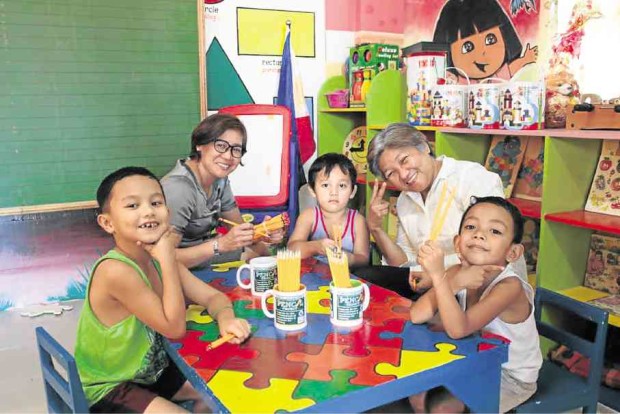
Hotel manager Cristy Alcantara (second from left) and Tagaytay City information officer Lani Diesta lead the way in educating Cavite preschool children, one pencil at a time. —CLIFFORD NUÑEZ
TAGAYTAY CITY—Six-year-old Dea Noelle would come home from school with her pencils broken. This happened often that her mother, Cristy Alcantara, 46, started wondering what was going on.
Alcantara enrolled Dea in a public day care outside this city, not that they could not afford a private school, but because she wanted to enhance her daughter’s social skills.
“[But] she would always ask me to buy her a new set of pencils, so I began asking why,” Alcantara said.
To her surprise, her daughter told her she broke her pencils so she could share these with her classmates.
Not into two parts, but Alcantara said the kids at school actually broke Dea’s pencils into three, “so more children could get a share.”
This broke her heart.
Disposable
In September 2015, Alcantara, hotel manager of the Summit Ridge Tagaytay and president of the Tagaytay Tourism Council, came up with the idea of soliciting used pencils from hotels and donating them to schools, where these are needed most.
In partnership with the Tagaytay City government, the council launched the Pencil Project, which stands for Program for the Enhancement of Competencies and Initiatives for Literacy. The council is composed of more than 200 hotels, restaurants and cafes, and bed- and-breakfast facilities in this tourist city known for its stunning view of the Taal Volcano.
“Not many children could go to school, more so afford pencils,” said Lani Diesta, city information and tourism officer.
But in hotels, for instance, during corporate conferences, pencils are almost disposable. These are cheap, selling for as low as P3 each, and are charged as part of booking packages, Alcantara said.
She said many hotel guests would not use or keep them so the pencils end up wasted.
“[Pencils] seem worthless to us, but to many children they are very important,” she said.
Strong support
The campaign drew strong support from business owners here, with some establishments donating boxes of brand new pencils. As a formal launch of the Pencil Project, the council organized a “Pencil Run,” a fun run at the Casino Filipino, where participants gave away pencils instead of paying registration fees.
By November 2015, the project had gathered 3,000 pencils and donated them to the Tagaytay City Central School.
A first-class city in Cavite province, Tagaytay (with 16 public elementary schools, four high schools and one local college) has a literacy rate of 99.91 percent, Diesta said. But there are still about 15 million illiterate children out there, most of them in remote or indigenous communities.
In Surigao, where Alcantara’s family hails, she said Manobo children would still use pieces of charcoal to write on banana leaves as they did not have a pen and paper.
“This is why we wanted to expand [the project] into a literacy campaign,” Diesta said.
It has also become her personal advocacy that in Christmas last year, Diesta asked her friends to give her pencils instead of expensive presents.
Out of the council’s funds, the Pencil Project, late last year, “dressed up” the public Beverly Hills Child Development Center in Barangay Guinhawa by donating story books, floor mats and, of course, pencils.
To date, the council has collected 10,000 to 12,000 used and new pencils from business owners and donors.
Diesta said that is more than enough for all 34 day care centers here so they they are looking for schools outside Tagaytay as beneficiaries.
“A pencil is a basic symbol of literacy. You a see a pencil and you think of education,” she said.